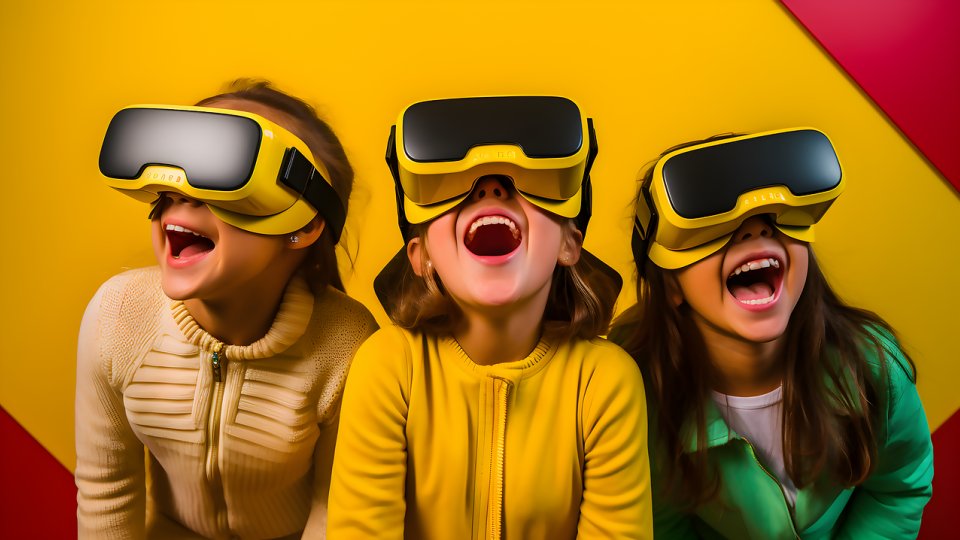As the summer holidays are in full swing, young people are using innovative and immersive technology to enhance their fun. Virtual reality (VR) experiences have become a popular and accessible way to dive into exciting games, explore imaginary worlds, and connect with friends. Described as co-creative and highly social by participants in an Ofcom survey, this growing trend of VR gaming and experiences offers a unique blend of entertainment and socialisation, redefining how many are spending their free time during the summer.
With any form of technology, it is important to know exactly what experience the young people in your care are having, and the benefits and considerations to consider, ensuring they stay safe online.
What is VR Gaming?
Virtual Reality (VR) gaming is a type of gaming experience that immerses players in a three-dimensional (3D), 360° virtual environment, allowing them to interact with that environment in a way that makes them feel like they’re living in a whole new world. Unlike traditional console or PC gaming, VR gaming uses advanced computer technology and hardware to provide a fully immersive experience.
Usually, VR gaming requires different components to work fully, including:
- VR Headset: VR headsets are worn like goggles and include screens that help to block out the real world and immerse people into the 3D, VR experience.
- Motion Controllers: Motion controllers are used to help players interact with the virtual world they’re in and can mimic a person’s hands to help pick up objects, aim at targets, and explore the world further.
- VR-Compatible Games: VR games are specifically designed for an immersive VR experience and can range from action to puzzle-solving genres.
New Adventures: Pros of VR Gaming
For many young people, VR has transformed into a virtual playground, enabling players to explore new worlds with their friends, away from their gaming chairs. Certain games have been specifically designed to encourage physical activity and social interaction, including games that get you running around on an American Football pitch, skiing down the Alps, and even skating on a virtual rink for a game of multiplayer ice hockey.
Alongside physical activity, VR games can also be used to encourage creative thinking and provide educational opportunities. Whether it be by delving into the deep ocean and studying the marine life within it, or by exploring space and understanding the experiences of astronauts living on the International Space Station, there are plenty of games that help to engage young people with their interests and hobbies. With these virtual opportunities, VR can promote creativity and provide young people with educational spaces.
Back to Reality: VR Gaming Considerations
Whilst VR Gaming opens up a world of opportunities for young people, it is also important to remember that like with any form of gaming or online activity, there are considerations to make to ensure that young people are using technology in a healthy and safe way. For anyone looking after a young person, it’s important to appropriately monitor their usage of VR and further forms of technology to ensure they can remain safe online.
- Screentime: During such immersive experiences, it can be hard to know when to turn off. With VR gaming experiences, playing in VR for long periods can lead to headaches and nausea. It’s important to set frequent breaks and ensure that young people maintain a healthy balance between their online and offline worlds.
- Age Ratings: VR gaming has created plenty of opportunities, but not all of them are child-friendly. With so many games available to download at the click of a button, make sure to ensure that VR games have appropriate age ratings, and understand the content included in the game.
- Online Interactions: Our interactions with others can have a huge impact on our wellbeing, and it’s important to ensure that young people are interacting with people appropriately online. Make sure to check if communication features are possible in VR games, whether there is age-appropriate moderation in place, and whether the games allow players to interact with strangers online and report abuse.
If something goes wrong whilst playing a VR game or you see something that causes harm, there are several ways you can report it depending on the VR system or gaming platform being used. For anyone looking to make a report across Meta Quest, PlayStation VR and VRChat, you can visit our website to find out common reporting routes.
Find Out More About VR and Gaming
As VR gaming advances, the ways it can be used are evolving rapidly. Young people are often at the forefront of embracing new technology, and it’s important to remain proactive in protecting them from online harm.
To learn more about VR and its various uses, you can visit the SWGfL Gaming Hub which provides in-depth guidance on VR and other forms of gaming, a dictionary of commonly used gaming terms, and information about online gaming communities and the gaming industry.






